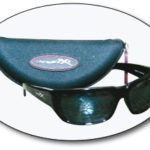Reign sunglasses with DuraLogic prescription lenses
Wiley X
Gloss Black Reign frames: $84
DuraLogic Polar True Grey lenses: $264
www.wileyx.com
Prescription glasses are something I know a thing or two about, having worn the things daily since I was 8 years old. They’re as much a part of my face as my nose, and over the years I’ve gone through countless pairs in arriving at my current state wherein my house and office are littered with a mess of eyewear including no less than five pairs of prescription sunglasses—everything from the proverbial cheap sunglasses to high-end, high-tech foam-insert riding specs.
I’m a four-eyed kind of guy, for sure, and so it was with some excitement that I greeted the announcement by Wiley X earlier this year of a breakthrough prescription lens manufacturing technology called “DuraLogic” they’d be bringing to their extensive line of military and sporting sunglasses. That initial excitement grew exponentially when the company offered to send me a pair of shades of my choosing made to my prescription for review. I always knew my astigmatism would somehow pay off one day.
I opted for the Wiley X Reign frames from their “Street” collection of motorcycle glasses since, from the looks of them, they had all of the attributes I sought in a pair of multi-condition riding specs; specs suitable for use with both faired and unfaired bikes in a wide range of operating environments. Chief among those attributes were good protective coverage, a snug fit to minimize wind blast on the eyeballs, generous peripheral field of prescription vision, and, above all, sinister good looks.
When the Reigns arrived, I wasn’t disappointed. They proved an excellent fit, enclosing my orbital sockets securely with little infringement from the frames on my big-picture view. The Italian-made frames are extremely sturdy, constructed of stout stuff and utilizing a pair of heavy-duty steel hinges.
So far, so good, but it’s the prescription lenses we’re here to examine, and in that examination we should start with what we already knew about the Wiley X lens quality, the standard of the industry.
Wiley X went into business in 1986 with the original objective of producing ballistic eyewear for military and law enforcement applications. As such, the polycarbonate lenses they employ are virtually indestructible, not only meeting the toughness standards applied to industrial safety glasses, but having been shown in testing to withstand close-range shotgun blasts, and shown in the real-world experience of combat to withstand the shrapnel of I.E.D.s. That’s comforting to know when following an open gravel truck on the highway or passing a mud-tired 4×4 on a dirt road—or riding through Utah when the Mormon crickets are hatching out. The lenses also eliminate 100 percent of harmful UV rays, and their polarized offerings neutralize virtually all glare.
And that’s all very impressive, but what about this new high-zoot DuraLogic prescription lens technology? It’s hard to imagine that a centuries-old device like a corrective lens could be improved upon even a little, much less in quantum-leap fashion, and Wiley X indeed has lofty claims for this technology, to wit: “DuraLogic lenses provide precise customized optics, brilliant color contrast and enhanced depth perception. The system brings extended prescription ranges and unmatched optical performance throughout the entire lens, reducing peripheral distortion inherent to high-curve wrap designs.”
Pretty amazing stuff, on the face of it, and the heart of the technology being employed is what’s called “digital processing” of the lens back—a means of fine-tuning virtually any prescription to work optimally with even the most radical lens shape. That process also makes it possible to expand the so-called “sweet spot” of your vision from the single focal point of conventional prescription lenses to a band extending across the entire lens.
In practice, the view through the DuraLogic lenses is indeed different in ways both subtle and distinct; so different, in fact, that they take some getting used to. Things appear more vivid and colors pop, even through the dark tint of the polarized lenses. There is an enhanced depth perception and image elements are more distinct and differentiated. At the same time there’s the sensation that you’re not looking through lenses at all, so superb are the optics and visual clarity across the entire field of vision. Extreme peripheral vision through the curved lenses is crystalline and utterly without the type of watery distortion experienced in other wrapped configuration sunglasses I’ve worn. It was all slightly distracting, initially, since I found my eyes trying to take in everything at once instead of focusing on individual details. I grew accustomed to that in short order, though, and since that time have found all my other sunglasses to be flat and lifeless—and neglected. The DuraLogic lenses are not cheap—the lenses as tested run $264, and progressive versions are $484—but for the chronically and committedly four-eyed among us, they’re worth every penny.




















